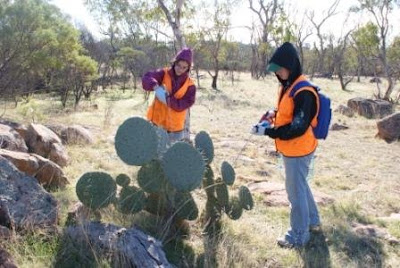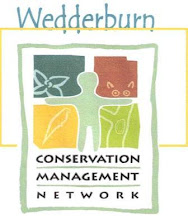
The weather over the past month has influenced local nature. The very hot weather brought on massive numbers of hoverflies and blowflies, then after some rain, termites took the opportunity to increase the size and height of their mounds. On a damp morning the observers noticed a very strong smell of liquorice in the bush. This unusual odour came from the flowering broom honey myrtle. This year the sweet bursaria is also flowering strongly and has a beautiful smell. You may notice it flowering on many roadsides, a spindly and very spiny bush, with small delicate creamy, very perfumed flowers. The yellow gum trees are flowering too and it is possible to catch the smell of honey from them. Masses of snowy white flowers can also be seen on Heath Tea Tree and delicate mauve bottle brush flowers are known as Totem –poles. Many plants and grasses have finished flowering during spring and are now producing seed. This in turn has led to increasing numbers of seed eating birds seen. WCMN observers have recorded observations of the endangered Northern Golden moth orchid in a previously unknown location. Their identity has been confirmed by DSE and is an important addition to known locations of this rare orchid. Even during the hot weather, Orchids continue to bloom. In this area slender onion orchids have been quite abundant. The soft chirping sounds that have filled the sky for an unusually long time belongs to large flocks of wood swallows. They are currently nesting and white browed wood swallows have been observed feeding young in a nest located in the precarious broken end of a tree branch. A newly refurbished and very large stick nest noted in the Wychitella Nature Conservation Reserve has been identified as the nest of a pair of little eagles. A stimulating month, there is always something interesting to observe. Wedderburn
Conservation Management Network “Observers”



























 The Wedderburn CMN’s focus area is of high conservation value with more than 25% vegetation cover in the Wedderburn/Wychitella area. There are also large areas of cleared and semi-cleared land with scattered blocks of bush and remnant vegetation on public and private land. It is a highly fragmented landscape caused by past land clearing for agriculture, mining, eucalyptus oil production and subdivision for housing. The focus covers an area of approximately 170,000 ha between the townships of Wedderburn and Wychitella, in the North Central Catchment area of the state of Victoria, Australia (see Map). The area includes fragmented public land blocks and freehold properties important for conservation of Box-Ironbark forests and woodlands. Members of the Wedderburn CMN were instrumental in the purchase of the 245 ha Nardoo Hills Reserve by Bush Heritage Australia, Australia’s largest nonprofit private land conservation organisation.
The Wedderburn CMN’s focus area is of high conservation value with more than 25% vegetation cover in the Wedderburn/Wychitella area. There are also large areas of cleared and semi-cleared land with scattered blocks of bush and remnant vegetation on public and private land. It is a highly fragmented landscape caused by past land clearing for agriculture, mining, eucalyptus oil production and subdivision for housing. The focus covers an area of approximately 170,000 ha between the townships of Wedderburn and Wychitella, in the North Central Catchment area of the state of Victoria, Australia (see Map). The area includes fragmented public land blocks and freehold properties important for conservation of Box-Ironbark forests and woodlands. Members of the Wedderburn CMN were instrumental in the purchase of the 245 ha Nardoo Hills Reserve by Bush Heritage Australia, Australia’s largest nonprofit private land conservation organisation.



